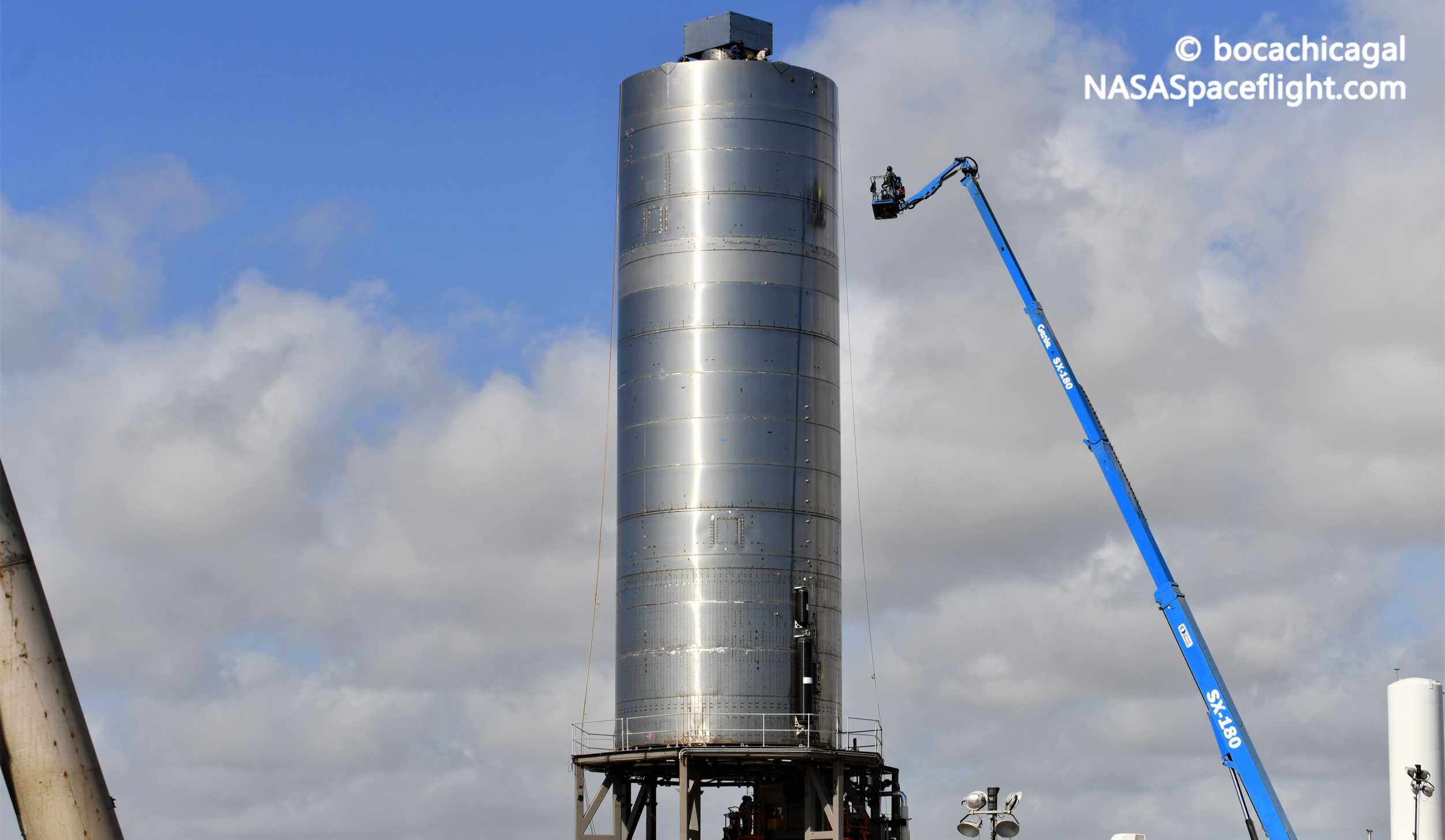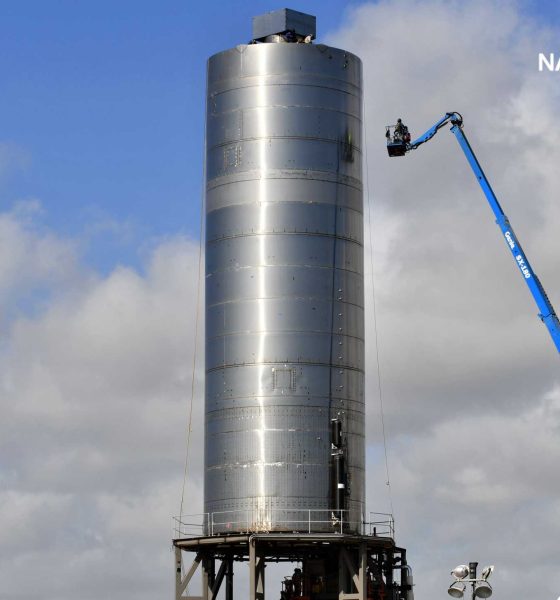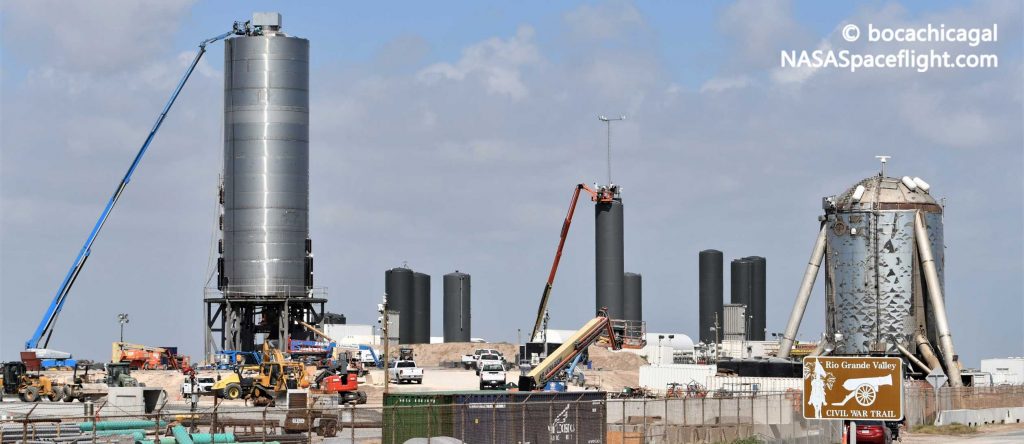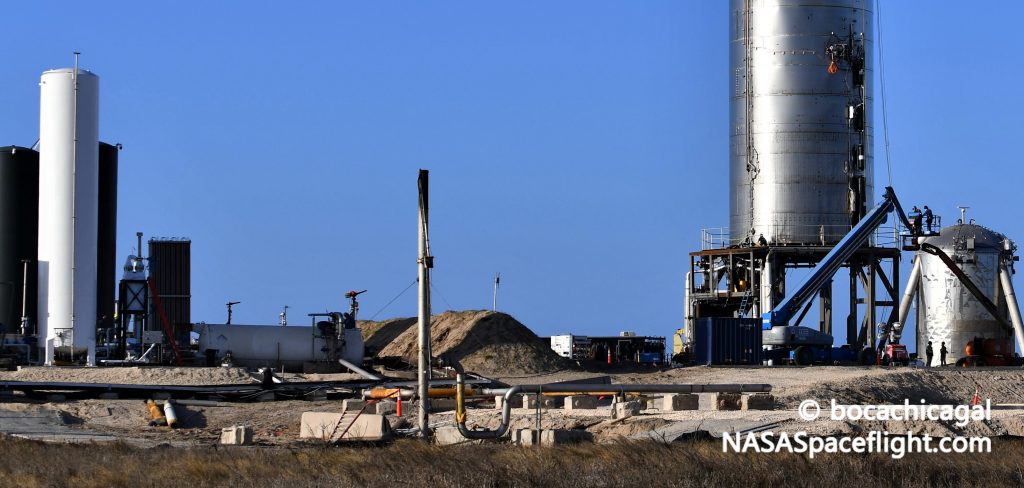

News
SpaceX Starship flight debut could happen this week, says Elon Musk
SpaceX CEO Elon Musk says that Starship’s full-scale flight debut could happen as early as this week if a suite of tests planned over the next few days goes according to plan.
The SpaceX leader also revealed a bit about the company’s plan to create its own custom steel alloy to build the best Starships possible – the first of which is already under construction. Beginning with Starship SN8, parts of which have already been spotted in work at SpaceX’s Boca Chica, Texas rocket factory, all future ships are expected to be built out of steel different than the 301 alloy used for all prior ships.
Of course, Starship SN8 is likely 2-4 weeks at best away from being ready for integrated testing. Instead, Starship SN5 is currently occupying SpaceX’s adjacent test stand and launch pad as teams work to prepare the rocket for several tests – potentially culminating in the first flight of a full-scale Starship.

For more than two weeks, SpaceX has been slowly preparing Starship SN5 for its first wet dress rehearsals and Raptor engine static fires. When a ground systems leak lead to a massive fuel-air explosion and Starship SN4’s destruction, it severely damaged the pad and required the construction of an entirely new launch mount.
Based on photos of the gradual rebuild taken by Boca Chica Village resident and photographer Mary (bocachicagal), SpaceX has visibly taken the opportunity to implement some significant changes (possibly upgrades) to the pad’s ground support equipment (GSE). Notably, the company has already installed a system meant to reclaim waste methane that would otherwise have to be burned at a flare stack, instead re-liquefying the gas a returning it to propellant storage tanks.

It’s unclear if SpaceX is attempting to onboard that new system as part of Starship SN5’s first major fueling tests, but the flare stack has not been active for weeks and the finicky nature of methane reclamation would certainly explain some of the 10+ days of delays.
On July 17th, after many day-by-day delays, SpaceX began Starship SN5’s first fueling test. The rocket appeared to be briefly pressurized with ambient-temperature gas (possibly methane and oxygen) but the test was quickly aborted. Another attempt on July 20th was also aborted after several hours with no frost (indicative of propellant loading). Finally, a third attempt on July 21st was canceled before it began, although a roadblock was briefly set up prior to the abort. Shortly after the abort, SpaceX published plans for another attempt at Starship SN5’s first WDR and static fire test on July 22nd with backup windows (8am-5pm CDT, UTC-5) on the 23rd and 24th.

First reported by NASASpaceflight.com, Elon Musk’s comment confirms their sourced information that Starship SN5’s flight debut could follow just a few days after a successful WDR and static fire. Given the sheer number of delays SN5’s test campaign has suffered, that’s far from guaranteed, but the ship certainly still has a shot at a hop test this weekend if things go perfectly over the next several days. Stay tuned for updates later today or tomorrow.
Check out Teslarati’s Marketplace! We offer Tesla accessories, including for the Tesla Cybertruck and Tesla Model 3.

News
Tesla FSD fleet is nearing 7 billion total miles, including 2.5 billion city miles
As can be seen on Tesla’s official FSD webpage, vehicles equipped with the system have now navigated over 6.99 billion miles.

Tesla’s Full Self-Driving (Supervised) fleet is closing in on almost 7 billion total miles driven, as per data posted by the company on its official FSD webpage.
These figures hint at the massive scale of data fueling Tesla’s rapid FSD improvements, which have been quite notable as of late.
FSD mileage milestones
As can be seen on Tesla’s official FSD webpage, vehicles equipped with the system have now navigated over 6.99 billion miles. Tesla owner and avid FSD tester Whole Mars Catalog also shared a screenshot indicating that from the nearly 7 billion miles traveled by the FSD fleet, more than 2.5 billion miles were driven inside cities.
City miles are particularly valuable for complex urban scenarios like unprotected turns, pedestrian interactions, and traffic lights. This is also the difference-maker for FSD, as only complex solutions, such as Waymo’s self-driving taxis, operate similarly on inner-city streets. And even then, incidents such as the San Francisco blackouts have proven challenging for sensor-rich vehicles like Waymos.
Tesla’s data edge
Tesla has a number of advantages in the autonomous vehicle sector, one of which is the size of its fleet and the number of vehicles training FSD on real-world roads. Tesla’s nearly 7 billion FSD miles then allow the company to roll out updates that make its vehicles behave like they are being driven by experienced drivers, even if they are operating on their own.
So notable are Tesla’s improvements to FSD that NVIDIA Director of Robotics Jim Fan, after experiencing FSD v14, noted that the system is the first AI that passes what he described as a “Physical Turing Test.”
“Despite knowing exactly how robot learning works, I still find it magical watching the steering wheel turn by itself. First it feels surreal, next it becomes routine. Then, like the smartphone, taking it away actively hurts. This is how humanity gets rewired and glued to god-like technologies,” Fan wrote in a post on X.
News
Tesla starts showing how FSD will change lives in Europe
Local officials tested the system on narrow country roads and were impressed by FSD’s smooth, human-like driving, with some calling the service a game-changer for everyday life in areas that are far from urban centers.

Tesla has launched Europe’s first public shuttle service using Full Self-Driving (Supervised) in the rural Eifelkreis Bitburg-Prüm region of Germany, demonstrating how the technology can restore independence and mobility for people who struggle with limited transport options.
Local officials tested the system on narrow country roads and were impressed by FSD’s smooth, human-like driving, with some calling the service a game-changer for everyday life in areas that are far from urban centers.
Officials see real impact on rural residents
Arzfeld Mayor Johannes Kuhl and District Administrator Andreas Kruppert personally tested the Tesla shuttle service. This allowed them to see just how well FSD navigated winding lanes and rural roads confidently. Kruppert said, “Autonomous driving sounds like science fiction to many, but we simply see here that it works totally well in rural regions too.” Kuhl, for his part, also noted that FSD “feels like a very experienced driver.”
The pilot complements the area’s “Citizen Bus” program, which provides on-demand rides for elderly residents who can no longer drive themselves. Tesla Europe shared a video of a demonstration of the service, highlighting how FSD gives people their freedom back, even in places where public transport is not as prevalent.
What the Ministry for Economic Affairs and Transport says
Rhineland-Palatinate’s Minister Daniela Schmitt supported the project, praising the collaboration that made this “first of its kind in Europe” possible. As per the ministry, the rural rollout for the service shows FSD’s potential beyond major cities, and it delivers tangible benefits like grocery runs, doctor visits, and social connections for isolated residents.
“Reliable and flexible mobility is especially vital in rural areas. With the launch of a shuttle service using self-driving vehicles (FSD supervised) by Tesla in the Eifelkreis Bitburg-Prüm, an innovative pilot project is now getting underway that complements local community bus services. It is the first project of its kind in Europe.
“The result is a real gain for rural mobility: greater accessibility, more flexibility and tangible benefits for everyday life. A strong signal for innovation, cooperation and future-oriented mobility beyond urban centers,” the ministry wrote in a LinkedIn post.
News
Tesla China quietly posts Robotaxi-related job listing
Tesla China is currently seeking a Low Voltage Electrical Engineer to work on circuit board design for the company’s autonomous vehicles.

Tesla has posted a new job listing in Shanghai explicitly tied to its Robotaxi program, fueling speculation that the company is preparing to launch its dedicated autonomous ride-hailing service in China.
As noted in the listing, Tesla China is currently seeking a Low Voltage Electrical Engineer to work on circuit board design for the company’s autonomous vehicles.
Robotaxi-specific role
The listing, which was shared on social media platform X by industry watcher @tslaming, suggested that Tesla China is looking to fill the role urgently. The job listing itself specifically mentions that the person hired for the role will be working on the Low Voltage Hardware team, which would design the circuit boards that would serve as the nervous system of the Robotaxi.
Key tasks for the role, as indicated in the job listing, include collaboration with PCB layout, firmware, mechanical, program management, and validation teams, among other responsibilities. The role is based in Shanghai.
China Robotaxi launch
China represents a massive potential market for robotaxis, with its dense urban centers and supportive policies in select cities. Tesla has limited permission to roll out FSD in the country, though despite this, its vehicles have been hailed as among the best in the market when it comes to autonomous features. So far, at least, it appears that China supports Tesla’s FSD and Robotaxi rollout.
This was hinted at in November, when Tesla brought the Cybercab to the 8th China International Import Expo (CIIE) in Shanghai, marking the first time that the autonomous two-seater was brought to the Asia-Pacific region. The vehicle, despite not having a release date in China, received a significant amount of interest among the event’s attendees.








